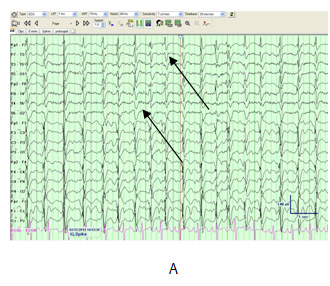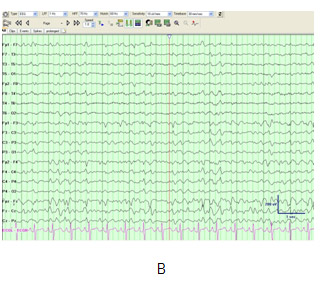- About ACNS
- Meetings
- Education
- Practice
- Research
- Advocacy
- Membership
A 63 year old right-handed female had a recent quintuple bypass for coronary artery disease with comorbid hypertension, diabetes, and chronic renal insufficiency. She was at home and suddenly collapsed, though was “immediately” resuscitated after her husband called 911. She was asystolic on arrival and in the ED had a witnessed “grand mal” seizure during intubation and was administered Levitiracetam (LEV) 1000 mg IV. A CT brain was normal. Neurology evaluation on arrival to the NICU demonstrated a comatose patient despite a transient reduction of neuromuscular blocking medication. What is featured on the EEG in (A), and what actions were taken to result in (B)?


Answer:
Figure: (A) A “stat” EEG demonstrating generalized periodic epileptiform discharges (GPEDs), and (B) after 3 cc of propofol. The recording parameters included are the longitudinal bipolar montage with a sensitivity 7 uv and filter settings of 1-70 Hz.
EEG in Coma Following Cardiac Arrest
Post-anoxic states include encephalopathic (monomorphic alpha/theta, triphasic waves, and burst-suppression) and epileptiform (PLEDs, BiPLEDs, GPEDs and NCSE) features on EEG. Epileptiform morphologies including GPEDs noted on the EEG in (A) may occur without overt clinical signs. When discharges are generalized, synchronous, high amplitude with limited intervening background, this suggests NCSE and usually reflects a poor prognosis1. However, the sharp waves that assume a triphasic appearance (negative-positive-negative waveforms) are controversial and challenge the reader to separate triphasic waves of encephalopathy from triphasiform GPEDs in ongoing NCSE (see arrow). With benzodiazepine administration (above), both the triphasic waves of encephalopathy and NCSE may temporarily remit2 and leave the distinction unresolved. After administration of AEDs and propofol, our patient remained comatose with repeated recurrences of GPEDs that persisted without clinical improvement. She died 3 days later.